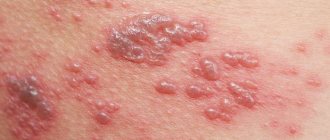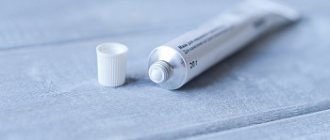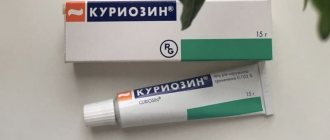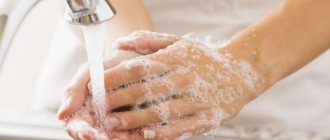A rash on the palms usually appears as itchy, painful spots that are red in color, blisters, or small blisters that are filled with pus. This rash is usually localized inside the palms. It can also appear between the fingers. Allergies, contact dermatitis - there really are plenty of reasons. If this is an allergy, then the trigger, that is, the irritant, can be cosmetics, household chemicals, pet hair, and so on.
But the rash may also be the result of some infectious disease. You can remember chickenpox, rubella, syphilis and so on. There may also be autoimmune disorders, such as psoriasis or rheumatoid arthritis. Finally, we must not forget about stress factors, heat and frost exposure, and the influence of medications.
Make an appointment with a dermatologist by phone or by filling out the online form
| Select a clinic | Demodicosis | Rash on shoulders | Dermatologist at home |
general information
Streptodermia refers to a pathology caused by streptococci. If we talk about the external manifestations of the disease, blisters and purulent rashes that itch appear on the skin.
Streptoderma in children can occur in two different forms: acute and chronic. Acute is characterized by pronounced symptoms, and chronic - by periodicity.
According to the degree of damage, the disease is classified into superficial, deep and intertriginous. Each form has a specific feature.
Symptoms
If streptoderma occurs, what is the treatment? Before we know the treatment options, let's find out the symptoms. The disease in children occurs in extremely severe forms:
- temperature up to 39C,
- poisoning,
- large lymph nodes.
The texture of the skin may vary depending on the form of the pathology:
- Superficial. Initially, red spots form on the skin. After a couple of days they turn into blisters with a certain liquid inside. The blisters grow up to two cm in diameter, after which they rupture. Yellow crusts form in this area. After this, the skin in this area heals, and the pathology develops further.
- Dry streptoderma . This form usually occurs in boys. Light and pink spots up to 5 cm in diameter form on the skin. They are found everywhere on the body. After they disappear, scars may remain.
- Streptococcal infection. The pathology extends specifically to the corners of the lips; it is encountered when there is a deficiency of vitamin B. Small cracks form on the skin, causing discomfort. After some time, they form into pustules that become crusty. The child has difficulty consuming food, as it causes pain.
- Felon. In a situation where streptococcus spreads to the area around the nails, panaritium develops. Oddly enough, this disease is more often encountered by children at an early age who bite their nails.
- Streptococcal diaper rash. This form of pathology is typical for breastfed children. Blisters form in the folds of the skin.
Understanding how streptoderma begins to develop in children, treatment which requires timely contact with a dermatologist and the implementation of therapeutic actions, not a minute can be lost. If you constantly put off going to the doctor, the pathology can develop into a chronic form, and it will be almost impossible to achieve a final cure.
streptoderma, treatment
Symptoms accompanying the appearance of a blistering rash
To promptly begin treatment for a rash on the palms and feet, it is important to show the child to the doctor on time. If an infectious etiology of the rash is suspected, a local pediatrician is called to the child’s home. If parents believe that the rash is caused by a food allergy, they can immediately make an appointment with a dermatologist.
It is important for parents to correctly describe the child’s well-being in order to help the doctor make the correct diagnosis. The rash is accompanied by additional symptoms:
- an increase in temperature to different values - high or low-grade;
- the appearance of clear nasal discharge;
- the appearance of nausea before vomiting, empty vomiting;
- refusal to eat;
- pain in the abdomen, in the larynx;
- general lethargy.
Parents should clearly tell the doctor what the child ate on the eve of the rash and what toys he played with. Maybe the cause of the blistering rash was an allergic reaction. But more often, the presence of small bubbles on the palms tells the doctor about the onset of an infectious disease, a helminthic infestation. Especially if the rash is accompanied by high fever, abdominal pain, and lack of appetite.
For your information!
It is strictly forbidden to miss such a condition or self-medicate the rash, otherwise you can miss it and cause a serious pathology.
Causes
The causative agent of streptoderma, the photo of which you will find below, is group A streptococcus. However, it is worth noting that infection can only develop in a situation where certain factors are present:
- skin damage,
- lack of following basic hygiene rules,
- weak immune system,
- disruption of the endocrine system,
- dermatological diseases,
- depressive mood
- vitamin deficiency,
- constant washing of the skin, which leads to damage to the protective layer,
- strong influence of different temperature ranges,
- poisoning,
- circulatory disorders.
Causes of blistering rashes
The most dangerous cause of a blistering rash on the palms and soles of a baby is meningococcal disease. When Neisseria meningitidis viruses enter the child’s body, the blisters bleed, the baby’s general condition sharply worsens, and a fever begins.
Lack of timely treatment often leads to death. A child's rash on the palms and feet in blisters of various types is shown in the photo. It is important to see the differences between different rashes. The main reasons for the appearance of a blistering rash:
- Allergy. It is caused by contact with house dust, stray animals, garden and field plants, and the appearance of new foods in the diet.
- Worm infestation.
- Bites by parasites and insects.
- Scabies, which is caused by the bite of a scabies mite. The child is worried due to constant itching, especially severe at night. This disease requires isolation of the child from other children.
- Inflammation of blood vessels and capillaries. In this case, the diagnosis is hemorrhagic rash. She is treated only in infectious diseases departments under the constant supervision of doctors.
- Measles, chickenpox.
- Diaper dermatitis, prickly heat.
- The beginning of the development of psoriasis.
Blistering rashes can be a sign of disease of the heart, blood vessels, and liver. Often neglected prickly heat develops into blistering rashes if hygiene rules are not followed. The doctor understands why a rash in the form of blisters appears on a child’s palms and feet, and he often takes photos to add to his collection of work experience.
Advice!
Before visiting a doctor, the child does not need to treat the rash with ointments or brilliant green so that the dermatologist sees a clear clinical picture.
Therapy
Streptoderma has occurred ? Even in cases where the initial examination was carried out by a pediatrician, only a dermatologist can select therapy. Doctors in this field have an understanding of drugs with a narrow scope of action.
The first step is to limit the child’s diet. The course of treatment also involves avoiding water procedures, which can cause the spread of the disease. Healthy areas of the skin should be washed with a solution of chamomile, and damaged areas should not be touched at all.
The sick person needs to choose the right wardrobe, from which items of clothing made from synthetics and wool must be removed.
Doctors advise popping blisters that form on the skin with a disinfected needle, after which the abscess should be drained twice a day. Healthy areas of the skin are washed with a boron solution.
If crusts appear on the skin, they should be treated with antibacterial gels or ointments.
In more complex situations, many other medications may be prescribed:
- antibiotics for streptoderma of the tetracycline or chloramphenicol series,
- means that prevent the occurrence of an allergic reaction,
- means aimed at improving the body's immune system,
- vitamin preparations,
- antipyretic.
The set of medications must be discussed with the doctor. With the right treatment, the symptoms disappear within a week, but after the severe form is eliminated, scars may remain. This is what streptoderma looks like .
what does streptoderma look like?
Is the rash on the palms contagious?
If the rash is caused by infectious diseases, fungi or parasites, then more often it is a contagious course of the disease.
These include:
- rubella;
- measles;
- meningitis;
- scabies;
- scarlet fever;
- chicken pox and so on.
Diseases are transmitted by airborne droplets, contact or household contact. With such diseases, the patient must be isolated from others until complete recovery. With helminthic infestations, it is also possible to infect other people in contact with a sick person if basic hygiene rules are not followed, for example, washing hands after using the toilet.
If the rash occurs due to an allergic reaction, then there is no threat of infection. Allergies are the individual characteristics of everyone’s body.
The cause of the rash should be determined as quickly as possible to ensure that it is not spread to others. Timely treatment will avoid serious consequences of the disease.
Answers to frequently asked questions about skin rashes:
- Which doctor should you contact for a skin rash?
- Is the skin rash contagious?
- What diet is necessary for skin rashes?
- What diagnosis is needed for a skin rash?
- Why is a skin rash dangerous?
- Why is it necessary to get tested for a skin rash?
- What diseases does a skin rash indicate?
- What examination is necessary for a skin rash?
- Which skin rash is dangerous?
- How to distinguish an allergic rash from an infectious one
- How to get rid of skin rashes?
- How to get rid of itching skin rash?
- What organs are affected by a skin rash?
- How to prepare for an appointment with a dermatologist?
- How to get checked for skin diseases?
- What diseases does a dermatologist treat?
- What tests should be taken by a dermatologist?
- What diagnostics can a dermatologist perform in the clinic?
- Where to go with a skin disease?
Causes of complications and re-infection
The reason for re-infection may be incorrect therapy when, for example, if you have primary criteria for improvement, you decide to stop therapy. The most important thing is to remember that you need to unquestioningly follow the advice and instructions of your doctor.
streptoderma complications
What can streptoderma be confused with?
Pyoderma
With pyoderma, the sebaceous and sweat glands are damaged. The rash appears in certain areas of the skin - parts of the body, scalp.
Herpetic rash
Herpes is characterized by the presence of blisters with constant inflammatory processes. They burst and provoke development.
Thrush or candidiasis
Candidiasis is characterized by erythematous papules or reddened, wet plaques. In the pathology under consideration, the lesion, as a rule, occurs in the mucous membranes or fold areas.
Manifestations of allergies
An allergic rash continues to occur as long as the influence is the causative agent of the allergy.
The most common causes of rashes on the palms
Usually an experienced dermatologist can make the diagnosis at a glance. However, in some cases additional diagnostics are required. It is important to pay attention to both the appearance of the rash and the circumstances that contribute to its appearance.
If the child is healthy, he does not have a fever or other symptoms of pathology, but there are isolated rashes on the palms, most likely, in this case we are talking about a contact allergy. A similar reaction is also possible when consuming certain medications or foods.
If the rash occurs against a background of elevated temperature or other signs of illness, it is necessary to conduct a comprehensive examination of the entire body. If the rashes, in addition to the palms, have spread to other parts of the body or mucous membranes, then a virus may be the cause of the problem.
Very often, rashes on the body are accompanied by infections such as the Coxsackie virus or enterovirus. To confirm and clarify the diagnosis, you will need to undergo a series of tests and, if necessary, visit related specialists.
Types of disease
- Streptococcal impetigo. The most common standard form of the disease. A characteristic rash forms on the face, arms and legs. This form is also the most limited, since the pathogen does not move beyond the upper layer of the skin, which has certain protective mechanisms. The appearance of the integument does not change, only individual blisters with liquid appear on the reddened areas. Initially, the patient will experience itching, after which the blisters become darker, which helps the blister to crust over. The duration of this process reaches one week. However, it is worth remembering that if the rash resolves, bacteria are further transferred to healthy areas of the integument, which has its negative consequences for the sick person.
- Bullous impetigo. The rashes are located on the arms and legs and had a fairly impressive diameter. Once the blisters open, these areas of skin develop ulcers that can spread quickly.
- Streptococcal diaper rash. Most of the patients are young children and overweight people. The location of the rash is under the mammary glands, in the axillary folds, intergluteal or inguinal-femoral folds. If you are overweight, the abdominal area is affected.
- Ringworm common. Appears in the form of bright pink rashes. The place of appearance is the face. The rash may become smaller due to exposure to direct sunlight. Those areas of the skin that are affected will not take on a tan like before.
- Streptococcal infection is characterized by the formation of blisters in the corners of the mouth. After the blisters disappear, a crack appears in their place, which in a matter of minutes becomes covered with a yellow crust. It also happens that children tear off the crust, but it forms again.
- Streptococcal ecthyma is the most complex form of the disease. The disease is accompanied by the appearance of characteristic lesions and scars on the arms and legs. In case of development of ecthyma, as a rule, there is a deterioration in health.
Therapy and drugs
Throughout the spread of the disease, basic hygiene rules should be observed: in the first days, it is forbidden to take baths and wet impetigo, and it is forbidden to comb the affected areas.
Therapy for this disease is aimed at destroying the pathogen and strengthening the protective functions of the immune system. As a complex treatment, antibacterial drugs of the category of cephalosporins, macrolides and penicillins are prescribed. If you have bullous streptoderma, you should stop taking medications. As an immunocorrective treatment, the drugs “Likopida”, “Amiksin” and their analogues are effective. Treatment with drugs for . Restoration of microflora in the intestines occurs with the help of probiotics and prebiotics. Appropriate antihistamines will help get rid of scabies.
Means that increase the body’s resistance to infections in the form of solutions - “Eleutherococcus”, “Echinacea”, “Leuzea”, etc.
Sets of vitamin nutrients should also be taken in accordance with the instructions.
Local treatment includes antiseptic drugs that prevent the spread of putrefactive bacteria. Such medications include various alcohols, brilliant green, as well as their analogues - “Fukartsin”, “Chlorhexidine”, “Miramistin”, “Rivanol” or the cauterizing agent “Resorcinol”.
The use of a huge number of zinc-based pastes, preparations and ointments for streptoderma in children with intense scabies.
Treatment of rash on palms
There is no general treatment regimen for rashes on the palms. It all depends on the diagnosis and the characteristics of the patient’s body. Treatment must be prescribed by a doctor. Before coming to the doctor, you should not use products that change the appearance and color of the rash - iodine, brilliant green, fucorcin.
Treatment is prescribed only after all tests have been completed. It includes:
- In simple cases, certain ointments and creams that are used to treat the affected areas of the body are sufficient. Sometimes tablet medications and injections are added to the treatment regimen. These can be hormonal, antiviral, antibacterial, antifungal, antihistamine drugs.
- Prescription of physical procedures. This includes ultraviolet treatment and other types of exposure.
- Children are prescribed baths with medicinal herbs that relieve itching and inflammation.
- For bacterial skin lesions, antibiotics are added to the treatment regimen in a certain dose.
- Vascular diseases require special treatment, using specific drugs.
- Sulfur and other ointments help with scabies. But the choice of remedy is determined by the doctor.
Folk remedies can complement treatment. Their feasibility is agreed with the doctor.
Preventive measures and prognosis
Due to the high risk of infection, sick children should keep their distance for some time and not contact other people. Quarantine is provided for up to 10 days. For the entire period of therapy, it is necessary to follow the rules of hygiene.
To prevent the development of the disease, it is necessary to disinfect the child’s personal belongings. Sick children should have a proper diet rich in nutrients. To improve the quality of the immune system, certain measures should be taken.
streptoderma treatment
As a rule, streptoderma ICD 10 in children is cured without any problems. Exacerbation of the disease and re-infection are observed mainly in children from disadvantaged families or in children with weak immunity. With timely treatment, symptoms disappear within one week. If you do not attach any importance to this, the disease can develop into a more severe form. In the worst case, the disease can lead to blood poisoning. For streptoderma, treatment with ointments and antibacterial agents is mandatory.
How to treat blistering rash on feet and palms
First, the doctor finds out the causes of the rash in order to make an accurate diagnosis and prescribe targeted treatment. In some situations, such as allergies or viral diseases, specific treatment is not required.
If reasons are identified:
- infectious etiology of the rash, then the bacteria that caused it are determined, and the doctor must prescribe antibiotics;
- allergies of various origins, the allergen is first identified, and then the doctor prescribes treatment to eliminate it, always with a course of antihistamines;
- vascular diseases, then the child is referred for consultation and further treatment with a hematologist;
- scabies, which can be seen by paired spots near the vesicle - the entrance and exit of the mite, then the child is sent to a dermatologist;
- mycotic infection, then treatment is aimed at getting rid of the fungal infection;
- affected by the herpes virus, its treatment is difficult, long, with frequent relapses;
- the onset of eczema, it is treated by a dermatologist. The disease is often allergic and infectious in nature. Treatment takes a long time, with frequent exacerbations. Accompanied by neuroses, insomnia;
- the onset of psoriasis, it is treated by a dermatologist. This is a disease from the group of dermatoses with an unknown etiology.
Even minor rashes should be seen by a doctor. Only he is able to identify their cause.
Prevention
To reduce the risk of infection, you should follow the following rules:
- follow the rules of hygiene,
- disinfect damage to the skin,
- strengthen the name system with useful substances,
- do not carry out frequent water procedures, as this may pose a certain danger for the child,
- In case of primary symptoms, you should immediately consult a doctor.
Streptoderma on the face can be treated, but only if you consult a doctor in a timely manner. The earlier therapy was carried out, the easier it is to exclude complications and transition to the chronic stage. You can undergo a full examination in a clinical clinic.
Preventing rashes on the palms
To prevent a rash on the palms from occurring, it is necessary to monitor the condition of the skin and follow hygiene rules.
General recommendations are:
- wash your hands thoroughly after contact with animals, after visiting public places;
- timely treat wounds and scratches with antiseptic agents (hydrogen peroxide, green diamond, fucorcin, iodine, and so on);
- take measures to prevent excessive sweating of the hands and feet;
- Make sure that the room is free of mosquitoes, ticks, bedbugs and other insects.
If a person notices a suspicious rash on his arms or hands, he should consult a doctor and not self-medicate.
There's no time to waste. The success of treatment depends on a correct diagnosis and timely, adequate treatment. Publication date: 2019-12-10
Methods for diagnosing skin diseases:
- Diagnosis of skin diseases
- Diagnosis of skin diseases at home
- Diagnosis of allergic skin diseases
- Diagnosis of bacterial skin diseases
- Diagnosis of viral skin diseases
- Diagnosis of hair diseases
- Diagnosis of nail diseases
- Diagnosis of skin tumors
- Skin scraping
- Blisters on the skin
- Dermatoscopy
- Demodex tests
- Diagnosis of sexually transmitted infections
- Mushroom tests
- Skin scraping










